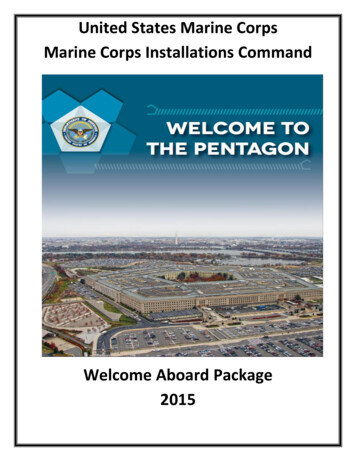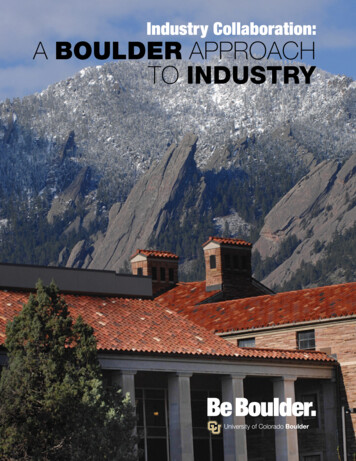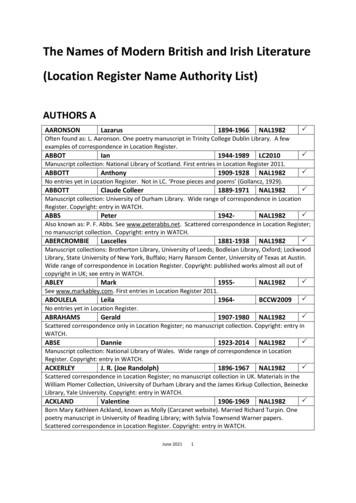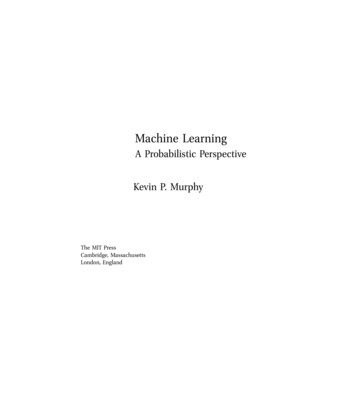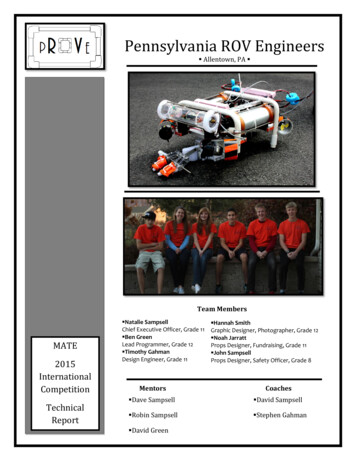
Transcription
British Marine Industry and the Diesel EngineDenis GriffithsIntroductionIn 1892 Rudolf Diesel lodged a patent for an internal combustion engine with the GermanPatent Office. From this beginning grew an industry which, a century later, providedpower for the majority of the world's merchant ships. Several inventors, including AkroydStuart and Emil Capitaine, had prior claims to internal combustion engines but Diesel'sversion employed compression ignition. He argued that compression to a sufficiently highpressure of the air charge in a cylinder would increase the air temperature to a point thatwould lead to spontaneous combustion of fuel subsequently injected into the cylinder. Inthese early engines fuel oil was forced into the cylinder by means of an air blast, the highpressure air atomising liquid fuel during injection. The engines of Stuart, Capitaine andothers offered internal combustion but did not rely solely upon compression of the aircharge to bring about ignition.Several companies took an immediate interest in Diesel's engine, includingMaschinenfabrik-Augsburg AG (later Maschinenfabrik-Augsburg-Numberg [MAN]) andSulzer Brothers of Switzerland. Several others quickly followed, including Mirrlees,Watson and Yaryan of Glasgow in 1897. When Diesel's patent expired during the earlyyears of the twentieth century, many other engine builders became interested and a widerange of engines operating on the Diesel cycle were developed. Diesel's patent coveredthe means of obtaining fuel ignition but there were two different methods by whichcylinders could be recharged with air, the four-stroke and the two-stroke cycles. Therewere, and still are, advantages and disadvantages to both, but the two-stroke has foundfavour for slow speed, direct-drive, crosshead engines while the four-stroke engine isconfined to the higher speed, trunk-piston type.The main problem as far as marine application was concerned lay in reversing theengine in order to go astern; electrical systems were tried but Sulzer introduced a directlyreversing engine in 1905 and other builders soon followed. Several builders concentratedon submarine engines, including M A N ; the French concern, Schneider and Co., and theItalian Fabbrica Italiana Automobili Torino (FIAT). Scott Shipbuilding and EngineeringCompany of Greenock took a licence for FIAT engines in 1912, while Barclay Curie onthe Clyde and Swan Hunter on the Tyne became interested in the engines developed byBurmeister and Wain (B&W) of Copenhagen. Subsequently, the association of theseconcerns was dissolved and a sole British licence to construct B&W engines was granted123The Northern Mariner/Le Marin du nord, VII, No. 3 (July 1997), 11-40.11
12The Northern Marinerto Harland and Wolff. The North Eastern Marine Engineering Company of Wallsend onTyne approached Werkspoor of Amsterdam for a licence in 1912, but the war delayedconstruction work. Beardmore took a licence for the Italian Tosi engine, whileRichardsons Westgarth held a licence for the Belgian-designed Carels engine. A numberof shipyards, including Dennys of Dumbarton, bought licences from Sulzer.45British Diesel EnginesVickers of Barrow worked closely with the Admiralty in the development of marine dieselengines, primarily for submarine propulsion, but a crosshead four-stroke cycle engine wasdesigned and fitted in a number of Admiralty-sponsored vessels, including the monitorMarshall Soult and the fleet replenishment tanker Trefoil; a slightly larger engine wentinto another fleet replenishment tanker which subsequently became the Marinula of theAnglo-Saxon Petroleum Company. After World War I a commercial engine was designedbased upon that crosshead engine, but with modifications aimed at reducing initial costand maintenance (see figure 1). Six pairs of engines were fitted in twin-screw tankersbuilt by Vickers, two were exported for installation in ships built in Japan and two largerengines were constructed for passenger ships also built by Vickers. An innovation as faras the Vickers engines were concerned was the solid injection of fuel into the cylinders;almost all diesels at that time used a blast of compressed air to force fuel into thecylinders. The engine was not a success, with only eleven ships fitted with the design, anumber of which suffered broken crankshafts and other serious failures (see appendixtable 1). The large eight-cylinder engines could develop just over 2000 kW, which wasinsufficient to propel the bigger and faster ships then being demanded. The companyrealised that its four-stroke design had reached the limit of development. Rather thanspend more money developing a new power plant, a licence was taken for the M A Ndouble-acting engine.6Swan Hunter obtained a licence from the Swedish engine designer AB DieselMotorer of Stockholm that became the basis for two different designs of Neptune enginesintroduced during the early 1920s, the so-called "A" and "B." Both operated on the twostroke cycle and used blast fuel injection. The essential difference between the two wasthat the "A" engine had scavenge air cylinders positioned below the main cylinders, withthe scavenge piston directly driven by the main piston (see figure 2). This produced avery tall engine but simplified cylinder head construction, since the scavenge cylinderscould be supplied with compressed air when starting, thus avoiding the need for startingair valves in the heads. The "B" engine had scavenge air pumps driven by levers fromsome of the main piston crossheads, thus reducing engine height; these levers were alsoused to actuate cooling water and lubricating oil pumps in a manner similar to theoperation of pumps on most steam reciprocating engines. Only three ships were fitted with" A " engines and eight with "B" engines (see appendix table 2), two of which actuallywere built by Swan Hunter for its own account (a number of companies would build shipsfor their own account in the hope of selling them before construction was complete; thisalso kept skilled labour employed). A l l Neptune engines were installed during 1924 and1925 and the income must have been marginal; no attempt appears to have been made tolicence the design.7
British Marine Industry and the Diesel EngineFigure 1:The Vickers four-stroke engine.Source:Engineering, CXII (15 July 1921), 132.13
14The Northern MarinerFigure 2:The Swan Hunter Neptune " A " engine.Source:The Motor Ship, III (October 1922), 228.Figure 4: Cylinder arrangements of the N B D E W two-stroke sliding-cylinder engine.Source:J . C . M . McLagan, "The Sliding Cylinder Double Acting Engine," Institute of MarineEngineers (IME), Transactions, X X X V I (1922-1923), 665.
British Marine Industry and the Diesel EngineFigure 3:Source:15The North British four-stroke engine.A . L . Mellanby, "Clyde Built Marine Oil Engines," I M E Transactions (June 1923), 714.Swan Hunter was also instrumental in establishing the North British Diesel EngineWorks at Whiteinch on the Clyde and effectively competed with itself for diesel engineorders during the difficult 1920s. North British designed two crosshead-type engines, a
16The Northern Marinerfour-stroke which was fitted in six ships and a notoriously unsuccessful sliding cylindertwo-stroke engine. The four-stroke engine had been designed during the First World Warand was effectively obsolete when introduced in 1921. There were two versions, with thelarger eight-cylinder engine developing 1675 kW and the smaller, higher-speed versiondeveloping only 373 kW (see figure 3). Four ships received twin large engines and twoships twin small engine installations. A l l but one of these vessels were for the BritishIndia Line (BI), which had an agreement with the Swan Hunter group to build and engineships on a cost plus 22.5% basis. As a result, the engines did not have to be competitivelypriced, and on the basis of payments by BI for main and auxiliary engines, the cost was 37.7 per brake horsepower (bhp), which compared unfavourably with other engines ofthe period (see appendix table 3). The sliding cylinder operated on the two-stroke cyclein an attempt to gain the advantages of a double-acting engine without the problemsassociated with the piston rod gland in a combustion zone (see figure 4). For manytechnical reasons the engine was not a success and failures occurred even during trials.Within two years all three ships fitted with this type of propulsion unit had been reengined (see appendix table 4).Richardsons Westgarth was at the fore of diesel engine development and in 1912installed a Carels engine in the pioneer British motorship Eavestone. The same year, thecompany obtained a licence for the Dutch Werkspoor engine, but this lapsed before anywere built. After the war Doxford and Beardmore-Tosi licences were obtained. Althoughplans were laid to collaborate with Beardmore to develop the Italian Tosi engine, littleprogress was made and the firm decided to engineer its own high-powered double-actingengine (figure 5) under the guidance of its enthusiastic engineer, W.S. Burn. Anexperimental unit was extensively tested in 1926 and 1927, but orders were difficult toobtain. In 1929 Richardsons Westgarth persuaded an owner to have a three-cylinderengine installed in the tanker Irania on a trial basis, but despite the apparent success nofurther orders were forthcoming. Development work continued and in 1934 four-cylinderengines were ordered for two Silver Line ships, favourable terms being obtained since theengine builder was "prepared to agree a very rigid form of contract.in view of theexperimental nature of the engine." Further funds were spent on development, but it wasnot until 1945 that any more orders were received. Later, five-cylinder versions wereinstalled in two standard design tankers (see appendix table 5). Despite the considerablesum expended, the engine's technical advances and the persistence of the company, it wasnot a great success commercially. Owners were reluctant to adopt unproven designs andpreferred to stick with those with established reputations.89A number of other British shipbuilders modified independent designs for marinepurposes. Cammell Laird obtained sole marine rights to the opposed-piston Fullagarengine (see figure 6) and succeeded in attracting three sub-licensees, but the total numberbuilt was small. Technical problems plagued the design and at one stage Laird faced courtaction from the Still Engine Company over patent infringement with respect to cylinderliner construction. Only nine ships received Fullagar engines and all but two had been reengined by 1930 (see appendix table 6). Unlike the majority of British engine designers,Cammell Laird attempted to develop a network of licensees but lacked the professionalapproach of its continental rivals. A North American agent was appointed on a
British Marine Industry and the Diesel Engine17commission basis, but as soon as a full-time job became available he departed, leavingthe firm with poor prospects of finding licensees in the U S .10airFigure 5:Source:startvalveRichardsons Westgarth double-acting engine.W.S. Bun, "Double Activity Engineers," Institute of Mechanical Engineers (IMechE)Transactions, X X X V I I I (1926), 281.
18The Northern MarinerScott of Greenock licensed the Still engine, which was more a concept for totalenergy recovery than an actual engine design (see figure 7). The basic principle was torecover as much waste heat as possible in the exhaust gases and engine cooling water bygenerating steam and using it to drive steam cylinders; the Still engine thus combineddiesel and steam. Much of the design work was undertaken by Scott's engineers. Thediesel operated on a two-stroke cycle. For the two engines fitted in the Blue Funnel'sDolius in 1924, the cylinders operated under combined internal combustion and steampower, with the latter acting on the lower part of the pistons and the former on the upper(see figure 8). Although efficient, there were technical problems due to oil entering thesteam system and to leakage when the cooling system operated at full boiler pressure. Theengines fitted in Eurybates in 1928 differed in design, employing five diesel cylinders andtwo separate steam cylinders. As a means of improving efficiency the Still concept wasuseful, but by the mid-1920s normal diesel efficiency had improved so much that thecomplexity of the design was not justified. Scott developed the diesel part of the engineand fitted engines in three ships, but there was no attempt to licence the design (seeappendix table 7). As Scott had an extensive warship order book, no further diesels werebuilt.11Figure 6:Source:A four-cylinder Fullagar engine.W . K . Wilson, "The History of the Opposed Piston Marine O i l Engine — Part 2," I M ETransactions, LXIII (1946), 180.
British Marine Industry and the Diesel Engine19Figure 8:Section through Scott-Still engine fitted in Dolius.Source:"Second Report of Marine Engine Trials Committee," IMechE Proceedings, I (1925),439.
20The Northern Marinerto atmosphereFigure 7:Source:Still engine operating system.W . J . Still, "Type of Still Engine for Marine Purposes," North East Coast Institute ofEngineers and Shipbuilders (NECIES) Transactions, XL (1924-1925), 393.Most successful of the British crosshead marine propulsion engines developedduring the First World War and introduced in the interwar years was the opposed-pistonDoxford engine. William Doxford and Son had been building on the River Wear since1840 and had a reputation for quality ships and machinery. As early as 1906 the firmbegan to experiment with internal combustion engines, but these used gas, which soonwas discovered to be unsuitable for ship propulsion. In 1910 development on a marine oilengine commenced and in 1913 an opposed-piston design evolved (see figures 9 and 10).Design work continued during the war and the first commercial engine was available in1919. By that time, Doxford had spent 100,000 on the engine, a not inconsiderable sumthat had to be recouped from sales or license fees. It was in the granting of licenses thatDoxford differed from its British counterparts, most of which had no licensees and hadto recoup development costs from their own sales. Doxford did not actively seek licenseesbut was willing to grant this right on application, with no limit to the number of licenses.An initial payment of 10,000 plus a royalty of 1 per bhp was required; Vickers, whichcontemplated taking a licence in 1924, considered this too high. By the end of the 1920sDoxford had four British licensees and two from overseas.12
21British Marine Industry and the Diesel EngineFigure 9:Source:Doxford three-cylinder opposed-piston "economy" engine.W . H . Purdie, "30 Years Development of Opposed Piston Machinery," IMechE Transactions, C L X I I (1950), 447.With a system of licensees Doxford could invest in design, enabling it to producean engine which could compete and so establish a reputation. While the engine had itsfaults, investment enabled these to be overcome and permitted it to enter other markets.The problem of diesel-induced vibration prevented extensive use of the engine inpassenger ships, but in 1926 Doxford decided to develop a balanced engine which couldcompete with steam in that lucrative market. The LB (long stroke, balanced) engine waseventually selected by Furness Withy for its luxury liner Bermuda. Small-bore engineswere introduced to enable it to compete in the low-power and industrial markets, althoughentry into the latter was unsuccessful. With improved trade following the depression ofthe early 1930s, four other British shipbuilders took licences, and by the end of thedecade the number of engines built by licensees exceeded those constructed by Doxforditself (for a chronology of Doxford engine development, see appendix table 8).13
22The Northern MarinerFigure 10: Arrangement of a four-cylinder Doxford engine with a centre scavenge pump.Source:W . K . Wilson, "The History of the Opposed Piston Marine O i l Engine — Part 1," I M ETransactions, LXIII (1946), 189.The British Marine IndustryInternal combustion engines were of interest to the Admiralty for use in submarines anda number of designs were investigated. In March 1917 a two-cylinder experimentalFullagar oil engine failed to impress the Admiralty, but their Lordships indicated awillingness to order at least two of the 1270-kW version upon satisfactory testing. Thiswas built by Laird and successfully tested, but when the war ended the Admiralty decidednot to pursue the idea. A considerable amount of investigative work was undertaken intointernal combustion engines by the Admiralty Engineering Laboratory and a number ofdifferent engines were tried, including a single-cylinder Doxford opposed-piston engineprocured shortly before the end of the war. The idea of an opposed-piston submarineengine was abandoned in favour of a more conventional single-piston four-stroke design.During World War I the needs of the nation were paramount and development onlarge British diesel engines had a low priority. But no such restrictions applied to majoroverseas competitors such as Sulzer, B&W or Werkspoor, all of which were able toimprove their designs. With the coming of peace, there was an apparent need formerchant shipping that could not be met fully by tonnage released from wartime duties.British yards, in general, met the demand by building traditional ships with steamreciprocating machinery and coal-fired boilers. By the early 1920s, however, the boom141516
23British Marine Industry and the Diesel Enginehad ended and the demand for tonnage plummeted. In the new climate shipowners wantedefficiency and low operating costs, which the large crosshead diesel engine could by thenoffer. Most British yards lagged behind their overseas competitors and there was antipathytowards the internal combustion engine despite its obvious advantages. Arguments againstdiesels emanated mainly from Britain and were particularly vociferous from coal interests.From the early 1920s, adoption of diesel propulsion was almost exclusively at the expenseof the coal-fired steamer (see figure 11).Figure 11:Source:Change in marine propulsion during the interwar years.Lloyd's Annual Review of Statistics,various years.The Case for Diesel PropulsionScandinavian owners adopted the diesel enthusiastically, in part because they had no fuelsources of their own; these owners wanted the most economical form of propulsion andquickly decided upon diesels. In 1923 Dan Brostrom, owner of the Swedish AmericaLine, commented that "no leading Swedish, Danish or Norwegian shipowner thinksseriously of any other class of vessel than the motor ship." Three years later, GunnarKnudsen of A . B . Borgestad was able to say that "thanks to the motor ships owned by our17
24The Northern Marinercompany, we hope to be able to promise the shareholders a constant dividend of 10% inthe coming years."18Figure 12: Proportion of motorships compared to steamships built, 1920-1940.Source:Annual Statistics, Lloyd's Register, various years.Diesel engines did make sense economically as far as many shipowners wereconcerned. In 1925 Furness Withy, a major British shipowner that favoured motorships,ordered five from Deutche Werft on the grounds of cost alone: the price of 150,000 pership was 60,000 to 100,000 per vessel less than British tenders. Its Chairman, SirFrederick Lewis, was willing to give the order to any British yard able to quote a priceeven 10,000 per ship more than the Germans, but there were no offers. The ships thushad German rather than British diesel engines.19
British Marine Industry and the Diesel Engine25Overseas yards quickly adopted the diesel and were in a position to offer it to anyowner who expressed an interest. Tonnage built in British yards tended to be steampowered while the rest of the world increasingly favoured diesel (see figure 12). Thecomplacency of shipbuilders on the northeast coast of England with respect to the dieselengine was attacked in a 1920 editorial in The Motor Ship, which opined that "they donot want the motor ship to progress because it would mean that they would be driven outof their complacency and [they would be] forced to deal with something new." Althoughsome shipbuilders argued that they held no brief for any particular engine, the magazine'seditor, A.P. Chalkley, found himself barred from several shipyards and contractors werewarned not to advertise in The Motor Ship unless they wished to risk future orders. Aslate as 1924, Readhead and Sons, the Tyneside shipbuilders, claimed that the reason theydid not offer diesels was that owners were not interested. The fact is that Readhead'sengine shops were only capable of building steam and the firm never took a licence tobuild diesels.202122The Influence of CoalMany arguments were put forward in favour of the steam engine, but the champions ofsteam were really battling for the British coal industry, which had suffered in the postwarperiod. Markets for coal had been lost as competition from other suppliers increased. In1928 Sir William Noble, chairman of the Cairn Line, which owned nine steamers and nomotorships, indicated his lack of understanding about engineering when he commentedthat the diesel was only a fashion, which he expected "to give another turn of the wheeland a normal increase in world consumption of bunker coal to be resumed." As well asbeing a prominent shipowner, Noble was also a director of the Blackwell Colliery, but hisrole as President of the UK Chamber of Shipping placed him in a very influentialposition. C.W. Cairns, also of Cairn line, likewise joined the battle between coal and oil."There are other ways in which coal can help in its fight against oil," he wrote, "such asthe adoption of geared turbine outfits.[T]he diesel engine has got very vocal supportwhilst those who ought to uphold coal say little."Arguments against the diesel and in favour of coal were even made in Parliament.Sir Robert Thomas came out firmly on the side of coal, although his remarks betrayed alack of understanding of marine engineering and shipping. "The internal combustionengine has had its day," he argued, adding that "he was sorry that so much British capitalwas sunk in it." Moreover, "he believed that the future of propelling power for shipswould rest with pulverised coal. That would mean not only an enormous saving in therunning of ships but also be of great help to our coal trade." Another champion ofsteam, and hence coal, was the eminent naval architect Sir John Biles. In a 1925 paperto the Institute of Naval Architects (INA), Biles advocated steam for practically everytype and size of ship; to advance his cause he used estimated costings for steam plants,which were then still at the development stage, and compared them with operational datafrom early diesels. Throughout May, a rather heated debate was carried on over thediesel in The Times among Lord Bearsted, chairman of Shell Transport and Trading; LordInvernairn, founder of the shipbuilders Beardmore; and Sir Fortescue Flannery, arespected naval architect. A year later Biles presented a second paper to the same2324252627
26The Northern Marinerlearned society in which he made some extravagant claims for steam at the expense ofdiesel. A third paper followed in 1928, this time addressing the question of fuel. Againabsurd claims were made, and during discussion of the paper a number of peoplequestioned the validity of the data. One individual commented that Biles' "diesel figuresappear lacking in foundation." Sir John admitted his real motives when he told anopponent that he might "monopolise all the prophesying he likes so long as he helps toincrease the use of British coal in place of foreign oil."28293031YEARFigure 13: British motorship completions, 1920-1940.Source:See figure 12.
27British Marine Industry and the Diesel EngineFigure 14: British-owned motorships, 1922-1940.Source:See figure 12.The general argument against marine diesels was that they burned imported oilrather than British coal. British shipbuilders were encouraged to stay with steam insteadof diesel and they did so (figure 13). Despite being the world's major shipbuilding andshipowning nation, in the interwar era Britain's share of the world motorship fleet barelychanged (see figure 14).Economic Advantages of the Diesel EngineThere was no doubt that, except for express passenger liners, diesels offered greater fueland space economy. Indeed, in 1924 no less a personage than the Chief SuperintendentEngineer of Blue Funnel admitted that "oil for marine purposes has come to stay."32
28The Northern MarinerAlthough diesel engines weighed more than steam-reciprocating engines orturbines when the weight of the boilers was taken into account, actual operating weightsfor similar steam and diesel plants were much the same (see appendix table 9). The spaceoccupied by bunkers in a diesel-engined ship was much less than for a steamer of similaroperating range, while the length of the engine room in the former was shorter per unitof power than in the latter (see appendix table 10). Diesels also required fewer engineroom hands, although capital costs were higher (appendix table 11), and these had to berecovered during the working life of the ship through higher charges.Appendix table 12 illustrates estimated operating costs for low- and high-poweredships based upon 1920 figures, while appendix table 13 compares working costs and cargoearnings for typical ships in 1922 and 1926. Only Blue Funnel published actual costs forships in its fleet, and this information confirmed the economic superiority of diesels. Onearea of shipping in which Britain was firmly established and in which the steamreciprocating engine reigned supreme was the tramp sector. Information provided by amajor Danish operator in 1921 showed that even here diesel-driven ships were the mosteconomical (see appendix table 14). As one shipbuilder put it, "within twenty years alltramp ships will be equipped with Diesel machinery."Fuel costs and cargo space were important to operating profits. Since diesel-drivenships could carry fuel in double-bottom tanks, and their engine rooms were shorter thanin steamships, they generally had a greater carrying capacity. In general diesel ships couldtravel further without bunkering than steam because of lower fuel consumption. For globaltrade, fuel supplies were difficult to guarantee, but as the diesel could travel farther beforebunkering, it was possible to take on fuel at the cheapest ports along the route. Duringthe 1920s the number of ports at which diesel-grade bunker oil could be obtainedgradually increased, thereby further reducing the advantage of coal on certain routes.Appendix table 15 illustrates the relative costs of coal and fuel oil at world ports in the1920s.Many countries, including Norway with its expanding fleet, had no indigenousfuel supplies to protect. For these nations, self-interest lay only in making a profit fromshipping. As a result, almost all Scandinavian tonnage built after 1918 was powered byinternal combustion engines. Germany lost many of its coal-producing regions and muchof its merchant tonnage as a result of the war; it, too, quickly adopted diesel propulsion.Some British owners also shifted to diesel, and the number of motorships in the Britishfleet increased. Yet it was not until close to the outbreak of World War II that Britishshipyards approached parity in terms of motor and steam construction (see figure 12).While the depression of the early 1930s restricted investment in new tonnage and inducedowners to retain older and less efficient coal-fired steamers, by the time the economicdownturn ended few British crosshead diesel engines were being produced.333435ConclusionsDuring the 1920s a number of British crosshead diesel engine designs evolved but mostfailed to make an impact as many domestic owners were encouraged to stay with the coalfired steamer. There were many reasons why these British engines failed to succeed,including technical faults and high initial cost, but the lack of orders limited the funds
British Marine Industry and the Diesel Engine29available for development. Not all British engines were technically inferior, either: theSwan Hunter Neptune and Scott diesels certainly had potential, although the shortage ofdevelopment funds was a definite hinderance. Moreover, the relatively high initial costof the diesel compared with steam must have deterred many British owners anddiscouraged some overseas owners from fitting British-designed engines which might bemore expensive than continental designs due to limited production runs.Continental designs such as B&W, M A N , Sulzer and Werkspoor received ordersbecause their shipyards built more diesel than steamships and because some British enginebuilders licenced them rather than developing their own or taking licences for otherBritish engines (see appendix table 16). Many British designs failed to attract licencesbecause the owning concern did not actively seek out such opportunities; even Doxford,builders of the most successful British marine diesel, did not attempt to attract licensees,although it was willing to grant permits upon application.Had there been more orders from British owners for motorships in the 1920s, itis highly likely that the British marine diesel engine industry would have prospered andthe domestically-owned shipping industry would have been more profitable due to loweroperating costs. The fact that Britain had such vast reserves of coal probably hindered itsmarine engineering and shipping during the interwar years, much as it had helped toinduce technological change in the nineteenth century. The influence of the coal lobbycertainly reduced the market for British diesels in the 1920s, as many shipowners andeven some shipbuilders were
engines were constructed for passenger ships also built by Vickers. An innovation as far as the Vickers engines were concerned was the solid injection of fuel into the cylinders; almost all diesels at that time used a blast of compressed air
